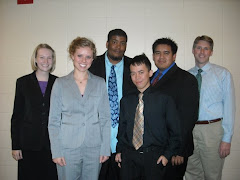So, what can you do in Forensics? What do you speak about? Why is it even fun to get up in front of people and speak?
Well, there are at least eleven categories that you could be involved in while in Forensics. Of course, it is impossible to be in all eleven, but the
SMSU team is proud to say that one member is in six of those categories. That is definitely an achievement! Along with the eleven categories, there are two basic categories that the eleven fit under--Public address and Interpretation.
The Public address category includes Impromptu Speaking, Informative Speaking, Extemporaneous Speaking, Persuasive Speaking, After-Dinner Speaking, and Communication Analysis. We will focus on these six events during this post.
Impromptu SpeakingThis event involves a lot of thinking on your feet. The speaker is given a quote or saying or even just a statistic on a piece of paper and they have seven minutes to construct a speech and give the speech. A good speech length is about four to five minutes which only leaves two to three minutes for the speaker to prepare what they are going to say. Speakers are definitely given an
adrenaline rush as they scramble for ideas to talk about!
Informative SpeakingThis event requires the speaker to write their own speech. They pick a topic, research the topic, and then write a eight to ten minute speech. The speech should be memorized, although speakers have a few tournaments where they can be "on script"--meaning, they have their speech with them while they are performing. To be more professional, the script must also be lined in black construction paper. As the semester progresses and you still happen to be on script, their are chances that you will not do as well. This event can also have visual aids. This helps the speaker explain their points more fully to the audience.
Extemporaneous SpeakingThis event is usually a small one since it is probably the most difficult. This is known as a "draw category" because speakers do not know what they will be giving a speech on until
thirty minutes before they speak. The pick a slip of paper out of an envelope which has their topic on it. Then they are given thirty minutes to draw upon the sources that they have collected to write a speech. The speech has to include source citations and should
ideally be eight to ten minutes in length. Those individuals who are in
Extemp. Speaking always carry around
briefcases and "traveling" filing systems.
Persuasive SpeakingThis event is very
similar to Informative Speaking, except for the fact that the content of the speeches are very different. The speeches in this event are also
written by the speaker but they are persuasive in nature. Other than that, the category is very similar to Informative.
After-Dinner SpeakingThis event is known as the "humorous event". Often
abbreviated to "ADS", this speech is also
written by the speaker. It is a persuasive speech that is humorous. The speech includes source citations as well. This event is also similar to Informative and Persuasive other than the content being different.
Communication AnalysisThis last Public Address event is also similar to Informative and Persuasive. The writer picks a famous (or not famous) speech from the past and critiques it. However, it doesn't just have to be a speech. The writer can pick a poem, poster, film, or campaign. Visual aids are often used in this event to help the speaker make their ideas clearer.
Well, those are all of the Public Address events! There are five more events that I will cover next time.
Have an awesome day!
